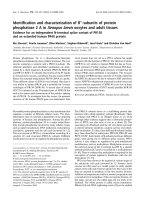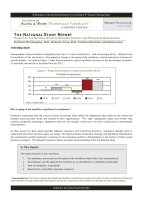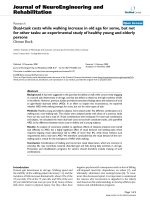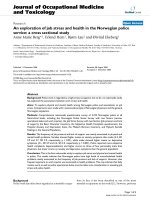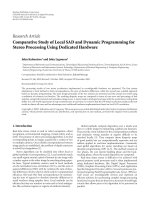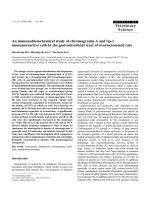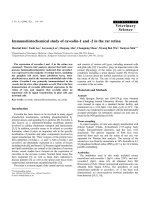Study protocol for an open-label, singlearm, phase Ib/II study of combination of toripalimab, nab-paclitaxel, and gemcitabine as the first-line treatment for patients with unresectable
Bạn đang xem bản rút gọn của tài liệu. Xem và tải ngay bản đầy đủ của tài liệu tại đây (793.16 KB, 8 trang )
Shui et al. BMC Cancer
(2020) 20:636
/>
STUDY PROTOCOL
Open Access
Study protocol for an open-label, singlearm, phase Ib/II study of combination of
toripalimab, nab-paclitaxel, and
gemcitabine as the first-line treatment for
patients with unresectable pancreatic
ductal adenocarcinoma
Lin Shui1†, Ke Cheng1†, Xiaofen Li1, Pixian Shui2, Xiaohan Zhou1, Jian Li3, Cheng Yi1 and Dan Cao1*
Abstract
Background: Pancreatic ductal adenocarcinoma (PDAC) is a fatal disease with a dismal response to single-use of immune
checkpoint inhibitors (ICIs). ICIs combined with systemic therapy has shown efficacy and safety in various solid tumors. Nabpaclitaxel and gemcitabine (AG), as the standard first-line treatment for advanced PDAC, has been widely used in recent
years. The combination of ICIs and AG chemotherapy appears to be a promising option in the treatment of PDAC.
Methods: This is an open-label, single-arm, and single-center phase Ib/II trial. The enrolled subjects are the
unresectable (locally advanced or metastatic) PDAC patients without previous systemic treatments. All subjects receive
an intravenous injection of gemcitabine 1000 mg/m2 and nab-paclitaxel 125 mg/m2 on day 1 and day 8, along with
toripalimab 240 mg at day 1 every 3 weeks. The subjects may discontinue the treatment because of progression
disease (PD), intolerable toxicities, requirements of patients or researchers. For local advanced patients who are
evaluated as partial response (PR), surgeons need to assess the surgical possibility. The primary objective of this trial is
to evaluate the safety and overall survival (OS) of this combination therapy; and the secondary objective is related to
the assessment of objective response rate (ORR), disease control rate (DCR), progression-free survival (PFS), and the rate
of resection or R0 resection after receiving toripalimab plus AG treatment. Besides, we expect to identify the predictive
biomarkers (such as MMR protein and PD-L1 expression, the number of TILs, the small RNA of EBV and so on) and
explore the correlation between these biomarkers and tumor response to this combined regimen.
Discussion: This trial is the first attempt to evaluate the efficacy and safety of the combination of toripalimab plus AG
chemotherapy as a first-line treatment for unresectable PDAC patients. The results of this phase Ib/II study will provide
preliminary evidence for further assessment of this combined therapeutic regimen for unresectable PDAC patients.
(Continued on next page)
* Correspondence:
†
Lin Shui and Ke Cheng contributed equally to this work.
1
Department of Abdominal Oncology, Cancer Center, West China Hospital,
Sichuan University, Chengdu, China
Full list of author information is available at the end of the article
© The Author(s). 2020 Open Access This article is licensed under a Creative Commons Attribution 4.0 International License,
which permits use, sharing, adaptation, distribution and reproduction in any medium or format, as long as you give
appropriate credit to the original author(s) and the source, provide a link to the Creative Commons licence, and indicate if
changes were made. The images or other third party material in this article are included in the article's Creative Commons
licence, unless indicated otherwise in a credit line to the material. If material is not included in the article's Creative Commons
licence and your intended use is not permitted by statutory regulation or exceeds the permitted use, you will need to obtain
permission directly from the copyright holder. To view a copy of this licence, visit />The Creative Commons Public Domain Dedication waiver ( applies to the
data made available in this article, unless otherwise stated in a credit line to the data.
Shui et al. BMC Cancer
(2020) 20:636
Page 2 of 8
(Continued from previous page)
Trial registration: Trial registration: ChiCTR (ChiCTR2000032293). Registered 25 April 2020 - Retrospectively registered.
Keywords: Pancreatic ductal adenocarcinoma, PD-1 blockade, Combination therapy, Clinical protocol
Background
Pancreatic ductal adenocarcinoma (PDAC) is a highly aggressive tumor with high mortality. Due to its insidious onset, a significant part of patients is initially diagnosed as
locally advanced or metastatic with a 5-year survival rate of
less than 9% [1]. Recently, the emergence of chemotherapy
regimens, such as gemcitabine combined with nab-paclitaxel
(AG) or FOLFIRINOX, improved the survival of patients
with the late-stage PDAC [2, 3]. Given the dismal overall
prognosis, novel treatment strategies are urgently needed to
further reform the treatment for unresectable PDAC.
Immune checkpoint inhibitor (ICI) is an established treatment and approved for multiple solid tumors. ICIs enhance
the anti-tumor immune response through stimulating
tumor-specific T cells, thus eliminating tumor cells and generating durable immune memory. Programmed death-1
(PD-1) is a receptor of the immunoglobulin family expressed
on the surface of activated T lymphocytes. PD-1 binds to its
ligand PD-L1 (B7-H1) to mediate the inhibitory signal of immune response and plays a critical role to regulate the peripheral tolerance and the mechanism of immunosuppression
or immune escape of tumor cells. PD-1/PD-L1 targeting
therapy has become one of the important advances in changing treatment decisions in a variety of solid tumors. However, the success of PD-1/PD-L1 blockades was not
replicated in PDAC. The single-use of PD-1 antibody has
not shown objective response in metastatic PDACs [4]. The
recent studies intended to improve the disappointing results
of ICI therapy, and increasing evidence indicated the synergistic function of PD-1 antibody and other systemic therapy.
Pembrolizumab combined with chemotherapy significantly
improved the objective effective rate and overall survival of
non-small cell lung cancer (NSCLC) patients compared with
chemotherapy alone, with good tolerance and manageable
side effects [5, 6]. The phase I studies of pembrolizumab
combined with nab-paclitaxel and gemcitabine chemotherapy (AG) have shown good safety and efficacy [7], including
those in digestive tract tumors [8, 9].
Besides, the potential population with favorable response to PD-1/PD-L1 blockades remains controversial.
According to ASCO clinical practice guideline, PD-1
blockades are recommended for patients with high
microsatellite instability (MSI-H) [10]. However, the incidence of MSI-H in PDAC is relatively low. Besides
MSI, PD-L1 expression and tumor mutation burden
(TMB) level [11–16] are also considered to potentially
predict the response to PD-1 antibody. The results of
this connection need to be confirmed in different tumor
types and different immunotherapeutic drugs. Furthermore, the diversity of T cell receptors (TCRs) in peripheral blood, the cloning of TCR in tumor tissue and the
number of tumor-infiltrating lymphocytes (TILs) are
also regarded as possible predictive biomarkers [17, 18].
In summary, given the impressive efficacy of AG chemotherapy and the good tolerance of PD-1 blockades combined with AG showed in a phase I study [13], we conduct
a phase Ib/II study enrolling 54 patients with unresectable
(locally advanced or metastatic) PDAC to explore the efficacy and safety of toripalimab (a PD-1 monoclonal antibody) plus AG. Mismatch repair (MMR) protein, PD-L1
expression, the subset of T cells in peripheral blood, the
TIL numbers and diversity of TCRs are estimated to identify the potential biomarkers for predicting the efficacy of
the combined regimen. This trial is expected to preliminarily indicate the feasibility of the combined therapeutic approach as the first-line treatment in advanced PDAC
patients and provide evidence for further research.
Methods/design
Design
This is an open-label, single-arm, and single-center phase
Ib/II trial. The enrolled subjects are the unresectable (locally advanced or metastatic) PDAC patients without previous systemic treatments. All subjects receive an intravenous
injection of gemcitabine 1000 mg/m2 and nab-paclitaxel
125 mg/m2 on day 1 and day 8, along with toripalimab 240
mg on day 1 every 3 weeks. After the patients sign the written informed consent, the treatment is administrated according to the protocol until the presence of disease
progression (PD) or intolerable adverse events. In the case
of grade 3 or higher adverse events (AEs), the treatment
should be suspended and the AEs should be actively treated
until returning to normal or grade 1 or 2. The next cycle of
treatment may reduce the dose according to the decision of
researchers. In addition, the medical safety team will review
all safety information during this clinical study.
Research hypothesis
The combination therapy of toripalimab plus GA as the
first-line treatment prolongs the survival of patients with
metastatic PDAC with good safety.
Objectives
Primary objectives
To evaluate the safety and overall survival (OS) of firstline treatment with toripalimab and AG chemotherapy
Shui et al. BMC Cancer
(2020) 20:636
(nab-paclitaxel plus gemcitabine) in patients with locally
advanced or metastatic pancreatic cancer without previous systemic treatments. Safety evaluation includes the
patients’ tolerance to this regimen and the influence of
these drugs on the skin, digestive tract, and electrolytes
balance of patients.
Secondary objectives
The evaluation of objective response rate (ORR), disease
control rate (DCR), progression-free survival (PFS), and
the rate of surgical conversion and R0 resection for toripalimab combined with AG chemotherapy in patients
with locally advanced or metastatic pancreatic cancer
without previous systemic treatment.
Exploratory objectives
The exploratory objectives of this trial are to further investigate the predictive biomarkers for the efficacy of the combination therapy. The following parameters of patients are
regarded as potential predictive biomarkers and the correlation between them and tumor response is explored.
1) In the tumor issues: the expression of DNA mismatch repair (MMR) protein and PD-L1, the number of
TILs, and the small RNA of Epstein-Barr Virus (EBV);
2) In the peripheral blood: T cell subsets (the absolute
counts of CD3, CD4, and CD8), the tumor markers, the
heat shock protein 90 α, EBV-EAD (early antigen)-IgG,
and EBV-VCA (viral capsid antigen)-IgA;
The following parameters of patients are estimated to
predict the clinical outcomes and prognosis of this combination therapy: the TMB level results from exome sequencing of ctDNA in the tumor tissue or peripheral
blood, the diversity of TCR in peripheral blood, and the
cloning of TCR in the tumor tissue.
Key eligibility criteria
The included patients are treatment-naive and unresectable (locally advanced or metastatic) patients with histopathologically confirmed PDAC. Besides, patients with an
Eastern Cooperative Oncology Group performance status
(ECOG PS) 0 to 2, adequate organ function, no history of
active autoimmune disease, and no treatment history of
ICI or chemotherapy, are eligible for this trial (detailed
key inclusion and exclusion criteria are listed in Table 1).
The course of the trial
The main process of the trial is summarized in Fig. 1. Patients diagnosed histopathologically as PDAC and confirmed by the surgeon or MDT group as unresectable are
included in this study. The entire course of the trial is expected to last more than 24 months. The subjects may discontinue the treatment because of progression disease
(PD), intolerable toxicities, and requirements of patients
or researchers. In addition, for the patients who complete
Page 3 of 8
6 cycles of the combination therapy, the subsequent maintenance of toripalimab monotherapy is considered according to the patients’ response and tolerance to the
treatment as well as the opinion of researchers. For the
PD during the period of maintenance treatment, toripalimab combined with AG chemotherapy may be used again
for systemic treatment. Pseudo progression possibly occurs during the immunotherapy, especially for patients
during the maintenance therapy of toripalimab. Pseudo
progression needs to be distinguished from true progression by the researchers, and the researchers need to determine whether to continue the therapy when pseudo
progression is confirmed. After the end of treatment, the
follow-up is conducted covering all patients to collect
anti-tumor treatment information and OS.
After the first appearance of imaging evidence of PD
evaluated by the Response Evaluation Criteria in Solid
Tumors (RECIST) v1.1, its revised version, the immunerelated RECIST (irRECIST), may be used to make treatment decisions according to tumor remission models of
PD-1 blockades. For clinically stable patients with the
first PD in imaging, the treatment may continue until
the radiologist researcher reconfirm the PD after at least
4 weeks. When the PD is reconfirmed by the researchers
or the radiologist researchers, the patients need to discontinue the treatment unless obtaining significant clinical benefits. Similarly, the evaluation of PD also needs
to be reconfirmed by the whole research group.
For patients who are evaluated as partial response (PR),
surgeons need to assess the surgical possibility. And for
the part of patients who have the opportunity to receive
R0 resection, the researchers need to communicate with
the patients about the necessity of operation and guarantee operation only for patients without surgical contraindications. In fact, the feasibility of surgical resection needs
to be considered during the whole therapy course by the
surgeons. The patients who successfully underwent R0 resection also need close follow-up for safety and survival.
The possible AEs throughout the trial need to be monitored and graded according to the conventional term criteria for adverse events (CTCAE) version 4.0. Severe
adverse events (SAEs) occurred within 90 days after the end
of treatment need to be recorded. If the patients start new
treatment, the AEs within 30 days need to be recorded.
The trial course consists of four phases of screening, baseline evaluation, treatment, and survival follow-up (Fig. 2).
Screening
The screening of patients, aiming at assessment of their eligibility for the trial, needs to be completed within 1 week
prior to the initial of treatment. The comprehensive information of potentially eligible patients are collected and recorded. Necessary procedures during the screening include:
sign of written informed consent, collection of demography
Shui et al. BMC Cancer
(2020) 20:636
Table 1 The key eligible criteria of this trial
Key inclusion and exclusion criteria
Inclusion criteria
Exclusion criteria
Age between 18 and 80 years
Synchronous or metachronous
(within 5 years) malignancies
Unresectable locally advanced or
metastatic pancreatic cancer that
is pathologically diagnosed as
adenocarcinoma
Females who are pregnant, or
lactating
No prior anti-tumor treatment for
pancreatic cancer
New known or suspected
uncontrolled metastases to brain
ECOG PS: 0 to 2
Serious or uncontrolled infectious
disease (HIV、active
tuberculosis、HBV DNA>103/ml)
Life expectancy ≥3 months
Active autoimmune disease
requiring systemic treatment in the
past 2 years
No history of autoimmune
diseases
Immunodeficiency, or receipt of
systemic steroid therapy or
immunosuppressive therapy within
7 days of the first dose of the study
drug
Adequent organ function as
below:
Tumor infiltration to any important
blood vessels and nerves
Absolute neutrophil count ≥1500/
mm3
Concurrent other kinds of
chemotherapy, targeted therapy,
hormone therapy, immunotherapy,
radiotherapy (except local
symptomatic radiotherapy) or
traditional Chinese medicine during
the trial course
Platelet count ≥80,000/mm3
History of chemotherapy or
immune checkpoint inhibitors
Haemoglobin ≥9.0 g/dL
Patients with serious complications,
such as:
Total bilirubin ≤2 × ULN
Uncontrollable cardiovascular
disease, angina and arrhythmia
Aspartate aminotransferase ≤3 ×
ULN (≤ 5 × ULN in patients with
liver metastases)
History of myocardial infarction
Alanine aminotransferase ≤3 ×
ULN (≤ 5 × ULN in patients with
liver metastases)
History of hemorrage or
thromboembolic events within the
last 6 months
Child-Pugh score ≤ 7
Uncontrollable diabetes mellitus or
hypertension
Uric acid< 500 μmol/L
Uncontrolled intestinal lung disease
or pulmonary fibrosis
Serum creatinine ≤1.7 mg/dL
Other patients who are considered
to be unsuitable for this study by
the investigator
Page 4 of 8
and medical history, physical examination, the evaluation of
PS score and the vital signs, and the test of clinical chemistry, hematology and coagulation, the liver and kidney function, cardiac biochemical markers and ECG. In the end, the
inclusion and exclusion criteria will be reviewed and the
final judgment on the subject’s eligibility will be made.
Baseline evaluation
Creatinine clearance ≥60 mL/min
Proteinuria ≤2 g/24 h
QTc interval ≤ 480 ms in ECG
The evaluation for the baseline status needs to be implemented within 2 weeks before the first treatment. In this
phase, the information specifically about the tumor needs
to be collected as the baseline level. Related procedures including the test of tumor markers (CA19–9, CEA), imaging evaluation (CT or MRI) and the expression of MMR
protein and PD-L1, the TMB level, the number of TILs,
the absolute counts of CD3, CD4, and CD8 T cells, the diversity of TCR, the cloning of TCR in the tumor tissue,
and the level of EBV-EAD-IgG or EBV-VCA-IgA.
Treatment
Because the safe dose of toripalimab has been verified in
other solid tumors, and nab-paclitaxel and gemcitabine
both are standard chemotherapy agents for advanced pancreatic cancer, we intend to use a fixed-dose instead of the
dose-escalation exploration in this study. The administration of the combined therapy is carried out as follows:
gemcitabine 1000 mg/m2 and nab-paclitaxel 125 mg/m2
infused intravenously (i.v.) on day 1 and day 8, along with
toripalimab 240 mg i.v. on day 1. Routine prophylactic
anti-vomiting, liver protection and best support treatment
should be initiated on day 1 of each cycle of chemotherapy, but other anti-tumor cytotoxic drugs, targeted drugs
or research drugs should not be accepted at the same
time. The necessities for patients to undergo palliative
radiotherapy or operations to control local symptoms during the study were evaluated by investigator. All combined
treatments should be recorded on the CRF form.
Tumor response and safety are evaluated every two or
three 21-day cycles of treatment, including the test of tumor
biomarkers and cardiac biochemical markers, as well as the
CT or MRI. Within 1 week prior to every repeated therapy
cycle, physical examination, conventional laboratory analyses
and tolerance assessment of the previous cycle of treatment
according to NCI-CTCAE v 4.0 are regularly performed.
The similar physical examination and efficacy or safety evaluation are also indispensable for the patients who are approved for discontinuing this trial. Besides, the information
about AEs and treatment discontinuation need to be recorded and the cause of death is indicated in case of death.
Written informed consent
Abbreviations: ULN Upper Limit Of Normal, ECOG PS Eastern Cooperative
Oncology Group performance status, ECG Electrocardiograph
Follow-up
During the follow-up phase, which begins from 30
days after the end of treatment to patients’ death,
acute or late toxicities and therapeutic efficacy of this
Shui et al. BMC Cancer
(2020) 20:636
Page 5 of 8
Fig. 1 The main process of this clinical trial. Abbreviation: AG chemotherapy, nab-paclitaxel plus gemcitabine; RECIST, Response Evaluation Criteria
in Solid Tumors. irRECIST, the immune-related RECIST
Fig. 2 General overview of the course of the trial. The trial consists of four phases: Screening, aiming at verification of patients’ eligibility for the
trial; Baseline evaluation, obtaining the basic information about the disease before treatment; Treatment, in which the combination therapy is
administered and the response evaluation and toxicities are investigated; Follow-up, observing the long-term safety and clinical efficacy of this
strategy. Abbreviations: PDAC, pancreatic ductal adenocarcinoma
Shui et al. BMC Cancer
(2020) 20:636
Page 6 of 8
combination therapy will be assessed by the indicators
described above. If no complication occurs, detailed
survival status and subsequent anti-tumor treatment
of patients are collected through telephone follow-up
every 2 or 3 months.
responsible to take appropriate measures for the AES and
determine the causal relationships between the adverse
events and the experimental drugs.
Outcome measures
Clinical efficacy assessment
The sample size of this trial is estimated using curative
effects as the estimation index. According to the Simon
two-phase method, alpha equals 0.05 (both sides) and
beta equals 0.2. On the basis of the 12-month OS rate
(35%) in the MPACT study, the 12-month OS rate of
this trial is expected to reach 55%. Therefore, 17 patients
are enrolled in phase I, and if one-year OS is less than 6/
17, which means less than six patients survived more
than a year, the trial will be suspended. To the contrary,
if the one-year OS is more than 6/17, 32 patients will be
enrolled in phase II. In total, this trial intends to enroll
at least 49 patients and the target sample size is 54 considering the 10% of patients may be lost to follow-up.
The following indicators are needed for the clinical efficacy assessment:
1) The objective response (OR): According to the
RECIST 1.1, OR is divided into the complete
response (CR), partial response (PR), stable disease
(SD) and progression disease (PD). In this trial, the
ORR is defined as CR + PR, and CR + PR + SD is
calculated as DCR. The size of the lesions (imaging
and physical evaluation) must be measured using
the same way throughout the trial for the accuracy
of comparative results. The 95% confidence
intervals of the ORR and DCR are calculated.
2) The survival outcomes: PFS is defined as the time
from initiation of treatment to the first confirmed
PD or cancer-related death. OS is the time from the
initiation of treatment to the death of patients.
Kaplane-Meier analysis is used to estimate and
determine for PFS and OS.
3) The resection rate is defined as the percentage of
initially unresectable patients who successfully
received the operation after at least one cycle of AG
plus toripalimab;
4) The R0 resection rate is defined as the percentage
of initially unresectable patients who successfully
received the R0 resection after at least one cycle of
AG plus toripalimab.
Pharmacodynamic analysis
Fisher precise test is used to analyze the correlation between ORR and these potential pharmacodynamic parameters (such as MMR status, PD-L1 expression, TIL number,
the cloning of TCR in TIL, T cell subsets in peripheral
blood and the diversity of TCRs in peripheral blood). The
frequency distribution diagram of tumor response and the
curve of biomarkers levels are portrayed when there exists
a correlation. The Cox proportional hazard regression analysis is used to investigate the relationship between tumor
response and biomarkers, respectively.
Safety assessment
The safety assessment includes observation and recording
of any grade of AEs and SAEs during the therapy course,
as well as the results of laboratory analyses and the ECG,
physical examination and PS score, etc. AEs are graded according to NCI-CTCAE 4.0. The researchers are
Statistical considerations
Estimated number of enrollments
Discussion
This trial is the first research to investigate the benefit and
toxicity of the triple combination of toripalimab and AG for
treatment-naive patients with unresectable PDAC. Toripalimab is a novel PD-1 antibody developed in China and is approved for refractory metastatic melanoma. It has a high
binding affinity, which enables it to bind its specific antigen
PD-1 receptor more firmly and compete better with PD-L1
and PD-L2 binding on tumor cells. Given its excellent safety,
toripalimab may act as a backbone and combine with other
systemic treatments to improve the response to ICIs [19].
Preclinical evidence supports the synergistic function between ICIs and chemotherapy. For instance, chemotherapy
is considered to prime the “cold” immuno-environment of
PDAC through increasing the expression of neoantigens or
limiting immunosuppression, thus synergistically enhancing
the anti-tumor immune response of ICIs [20]. Some phase I/
II studies have confirmed the improvement of anti-tumor efficacy of chemotherapy combined with ICIs in various solid
tumors [5, 21, 22]. The combination of toripalimab plus capecitabine and oxaliplatin was proved to effective and tolerable for patients with advanced gastric cancer, with the ORR
of 66.7%, the DCR of 88.9%, and the SAEs incidence of
38.9% [23]. However, limited data about the combination of
ICIs and chemotherapy against PDAC, with the ORR ranging from 14 to 80%. Therefore, the concurrent treatment of
toripalimab plus AG chemotherapy represents a potential
approach and is necessarily investigated for unresectable
PDAC patients.
Safety profiles are also an indispensable part investigated
in this trial to affect the therapy selection of patients. For
the unresectable patients who received the combination
treatment of nivolumab plus AG chemotherapy, a study
has demonstrated that the most common grade 3 or 4
Shui et al. BMC Cancer
(2020) 20:636
AEs were anemia (33%) [24]. As a phase II trial indicated,
the treatment-naive metastatic PDAC patients received
the combination of four drugs, including AG chemotherapy plus doublet ICIs (durvalumab and tremelimumab),
and the most frequent grade 3 or higher AEs were hypoalbuminemia (45%), abnormal lipase (45%) and anemia
(36%) [25]. The rate of grade 3 or higher AEs of immunochemotherapy ranges from 33 to 76% according to previous research. Besides, for the initially unresectable patients
who receiving the curative surgery, the neoadjuvant combination therapy induces impressive tumor response to
transform “unresectable” to “resectable” and good safety
to tolerate subsequent operation. Previous studies demonstrated that neoadjuvant nivolumab induced a major
pathological response in order to completely resected [26].
Neoadjuvant combination of pembrolizumab, capecitabine, and radiotherapy also had a manageable safety profile in PDAC without delaying the surgery [27].
In addition, the biomarkers that are suggested to
predict the sensitivity of ICIs in other types of tumors, such as MMR deficiency, MSI status and TMB,
are identified relatively rare in PDAC patients. For example, MMR deficiency is identified occurring at a
frequency of 0.8% [28], meanwhile, MSI status is
found in 2% of pancreatic patients. The investigation
about novel potential biomarkers for predicting the
response to PD-1 blockades in PDAC is desperately
needed. Increasing analyses showed the potential
value of PD-L1 overexpression to select a wider population to benefit from the PD-1 blockades [29, 30]. In
advanced gastric cancer, pembrolizumab showed a
higher ORR in patients with positive PD-L1 expression than non-selected patients [31]. In the patients
with PD-1 positive expression (≥50%), pembrolizumab
was proved to induce a significantly better PFS, therefore
being approved as a first-line treatment for metastatic
NSCLC patients with PD-1 overexpression (≥50%) [11].
Nevertheless, its application in PDAC has yet to be validated. TILs are the effector immune cell to directly affect
the immune response. The subsets of TIL, the ratio of
CD3+, CD8+, and granular enzyme B(GZMB) + T cells
are regarded as predictive parameters in colon cancer
[32]. The significant connection of TILs and the response
to ICIs is proved in melanoma [33]. However, in PDAC
patients, the expression of TIL and PD-L1 may be insufficient to predict the clinical outcomes of neoadjuvant
GVAX vaccination [34]. Moreover, the underlying viral infection is suggested to be more sensitive to PD-1 blockades. A recent study found a 100% response to
pembrolizumab in six EBV-positive patients with advanced gastric cancer [35]. Overall, a comprehensive landscape of tumor immunoenviroment, including a set of
indicators, may be fully qualified for selecting the optimal
treatment for individual patients.
Page 7 of 8
In conclusion, this trial is the first attempt to evaluate
the efficacy and safety of the combination of toripalimab
plus AG chemotherapy as a novel first-line selection for
unresectable PDAC patients. The results of this phase
Ib/II study will provide preliminary supports for further
assessment of this combined therapeutic regimen for
unresectable PDAC patients.
Abbreviations
AEs: Adverse events; AG: Nab-paclitaxel plus gemcitabine;
CTCAE: Conventional term criteria for adverse events; DCR: Disease control
rate; EAD: Early antigen; EBV: Epstein-Barr Virus; ECG: Electrocardiograph;
ECOG PS: Eastern Cooperative Oncology Group performance status;
ICIs: Immune checkpoint inhibitors; irRECIST: The immune-related RECIST;
MMR: Mismatch repair; MSI: Microsatellite instability; NSCLC: Non-small cell
lung cancer; ORR: Objective response rate; OS: Overall survival;
PD: Progression disease; PD-1: Programmed death-1; PDAC: Pancreatic ductal
adenocarcinoma; PD-L1: Programmed death ligand-1; PFS: Progression-free
survival; PR: Partial response; RECIST: Response Evaluation Criteria in Solid
Tumors; SAEs: Severe adverse events; TCR: T cell receptors; TMB: Tumor
mutation burden; TILs: Tumor-infiltrating lymphocytes; ULN: Upper limit of
normal; VCA: Viral capsid antigen
Acknowledgements
We owe thanks to the patients in our study and their family members.
Authors’ contributions
DC designed the investigation and contributed to writing the paper. LS and
KC participated in the administration of this study and contributed to writing
the paper. XL and XZ were involved in the obtain of ethical approval. JL, PS
and CY provided essential assistance and gave suggestions to this
manuscript. DC, KC and LS performed the research and supervised the study.
The authors read and approved the final manuscript.
Funding
This work was funded by the National Natural Science Foundation of China
(No. 81773097) and 1·3·5 project for disciplines of excellence-Clinical Research
Incubation Project (West China Hospital, Sichuan University). One of the drug
toripalimab was provided for free by the TopAlliance company (Shanghai,
China). The funding source had no direct role in the design of this protocol,
and had no direct role in the collection, analysis and interpretation of data.
In addition, the funding source had no role in drafting and revision of the
manuscript, and had no role in the decision to submit results for presentation or publication.
Availability of data and materials
The datasets used and analyzed during the current study are available from
the corresponding authors on reasonable request.
Ethics approval and consent to participate
The study protocol is approved by West China Hospital of Sichuan University
Clinical Trial Ethics Committee (HX-IRB-AF-14-V3.0). Changes to the protocol
will be communicated via protocol amendment by the study principal
investigators. Written informed consent will be obtained from all participants.
Consent for publication
Not Applicable.
Competing interests
The authors declare that they have no competing interests.
Author details
1
Department of Abdominal Oncology, Cancer Center, West China Hospital,
Sichuan University, Chengdu, China. 2School of Pharmacy, Southwest Medical
University, Luzhou, China. 3Department of Pharmacy, The Affiliated
Traditional Chinese Medicine Hospital of Southwest Medical University,
Luzhou, China.
Shui et al. BMC Cancer
(2020) 20:636
Received: 11 May 2020 Accepted: 1 July 2020
References
1. Siegel RL, Miller KD. Cancer statistics, 2020. CA Cancer J Clin. 2020;70:7–30.
2. Neoptolemos JP, Kleeff J, Michl P, Costello E, Greenhalf W, Palmer DH.
Therapeutic developments in pancreatic cancer: current and future
perspectives. Nat Rev Gastroenterol Hepatol. 2018;15:333–48.
3. Nevala-Plagemann C, Hidalgo M, Garrido-Laguna I. From state-of-the-art
treatments to novel therapies for advanced-stage pancreatic cancer. Nat
Rev Clin Oncol. 2020;17:108–23.
4. Patnaik A, Kang SP, Rasco D, Papadopoulos KP, Elassaiss-Schaap J, Beeram
M, et al. Phase I study of Pembrolizumab (MK-3475; anti-PD-1 monoclonal
antibody) in patients with advanced solid tumors. Clin Cancer Res. 2015;21:
4286–93.
5. Langer CJ, Gadgeel SM, Borghaei H, Papadimitrakopoulou VA, Patnaik A,
Powell SF, et al. Carboplatin and pemetrexed with or without
pembrolizumab for advanced, non-squamous non-small-cell lung cancer: a
randomised, phase 2 cohort of the open-label KEYNOTE-021 study. Lancet
Oncol. 2016;17:1497–508.
6. Frederickson AM, Arndorfer S, Zhang I, Lorenzi M, Insinga R, Arunachalam A,
et al. Pembrolizumab plus chemotherapy for first-line treatment of
metastatic nonsquamous non-small-cell lung cancer: a network metaanalysis. Immunotherapy. 2019;11:407–28.
7. Weiss GJ, Blaydorn L, Beck J, Bornemann-Kolatzki K, Urnovitz H, Schutz E, et al.
Phase Ib/II study of gemcitabine, nab-paclitaxel, and pembrolizumab in
metastatic pancreatic adenocarcinoma. Investig New Drugs. 2018;36:96–102.
8. Bang YJ, Van Cutsem E, Fuchs CS, Ohtsu A, Tabernero J, Ilson DH, et al.
KEYNOTE-585: Phase III study of perioperative chemotherapy with or
without pembrolizumab for gastric cancer. Future Oncol. 2019;15:943–52.
9. Kato K, Shah MA, Enzinger P, Bennouna J, Shen L, Adenis A, et al. KEYNOTE590: Phase III study of first-line chemotherapy with or without pembrolizumab
for advanced esophageal cancer. Future Oncol. 2019;15:1057–66.
10. Marcus L, Lemery SJ, Keegan P, Pazdur R. FDA approval summary:
Pembrolizumab for the treatment of microsatellite instability-high solid
tumors. Clin Cancer Res. 2019;25:3753–8.
11. Herbst RS, Baas P, Kim DW, Felip E, Perez-Gracia JL, Han JY, et al.
Pembrolizumab versus docetaxel for previously treated, PD-L1-positive,
advanced non-small-cell lung cancer (KEYNOTE-010): a randomised
controlled trial. Lancet. 2016;387:1540–50.
12. Chabanon RM, Pedrero M, Lefebvre C, Marabelle A, Soria JC, Postel-Vinay S.
Mutational landscape and sensitivity to immune checkpoint blockers. Clin
Cancer Res. 2016;22:4309–21.
13. Schumacher TN, Schreiber RD. Neoantigens in cancer immunotherapy.
Science. 2015;348:69–74.
14. Rizvi NA, Hellmann MD, Snyder A, Kvistborg P, Makarov V, Havel JJ, et al.
Cancer immunology. Mutational landscape determines sensitivity to PD-1
blockade in non-small cell lung cancer. Science. 2015;348:124–8.
15. Gibney GT, Weiner LM, Atkins MB. Predictive biomarkers for checkpoint
inhibitor-based immunotherapy. Lancet Oncol. 2016;17:e542–e51.
16. Goodman AM, Kato S, Bazhenova L, Patel SP, Frampton GM, Miller V, et al.
Tumor mutational burden as an independent predictor of response to
immunotherapy in diverse cancers. Mol Cancer Ther. 2017;16:2598–608.
17. Postow MA, Manuel M, Wong P, Yuan J, Dong Z, Liu C, et al. Peripheral T cell
receptor diversity is associated with clinical outcomes following ipilimumab
treatment in metastatic melanoma. J Immunother Cancer. 2015;3:23.
18. Hsu M, Sedighim S, Wang T, Antonios JP, Everson RG, Tucker AM, et al. TCR
sequencing can identify and track Glioma-infiltrating T cells after DC
vaccination. Cancer Immunol Res. 2016;4:412–8.
19. Gong J, Hendifar A, Tuli R, Chuang J, Cho M, Chung V, et al. Combination
systemic therapies with immune checkpoint inhibitors in pancreatic cancer:
overcoming resistance to single-agent checkpoint blockade. Clin Transl
Med. 2018;7:32.
20. Zitvogel L, Galluzzi L, Smyth MJ, Kroemer G. Mechanism of action of
conventional and targeted anticancer therapies: reinstating
immunosurveillance. Immunity. 2013;39:74–88.
21. Rizvi NA, Hellmann MD, Brahmer JR, Juergens RA, Borghaei H, Gettinger S,
et al. Nivolumab in combination with platinum-based doublet
chemotherapy for first-line treatment of advanced non-small-cell lung
Cancer. J Clin Oncol. 2016;34:2969–79.
Page 8 of 8
22. Weiss GJ, Waypa J, Blaydorn L, Coats J, McGahey K, Sangal A, et al. A phase
Ib study of pembrolizumab plus chemotherapy in patients with advanced
cancer (PembroPlus). Br J Cancer. 2017;117:33–40.
23. Wang F, Wei XL, Wang FH, Xu N, Shen L, Dai GH, et al. Safety, efficacy and
tumor mutational burden as a biomarker of overall survival benefit in
chemo-refractory gastric cancer treated with toripalimab, a PD-1 antibody
in phase Ib/II clinical trial NCT02915432. Ann Oncol. 2019;30:1479–86.
24. Wainberg ZA, Hochster HS, George B, Gutierrez M, Johns ME, Chiorean EG,
et al. Phase I study of nivolumab (nivo) + nab-paclitaxel (nab-P) ±
gemcitabine (gem) in solid tumors: interim results from the pancreatic
cancer (PC) cohorts. J Clin Oncol. 2017;35:412.
25. Renouf DJ, Dhani NC, Kavan P, Jonker DJ, AC-c W, Hsu T, et al. The
Canadian cancer trials group PA.7 trial: results from the safety run in of a
randomized phase II study of gemcitabine (GEM) and nab-paclitaxel (nab-P)
versus GEM, nab-P, durvalumab (D), and tremelimumab (T) as frst-line
therapy in metastatic pancreatic ductal adenocarcinoma (mPDAC). J Clin
Oncol. 2018;36:349.
26. Forde PM, Chaft JE, Smith KN, Anagnostou V, Cottrell TR, Hellmann MD.
Neoadjuvant PD-1 blockade in Resectable. Lung Cancer. 2018;378:1976–86.
27. Katz MHG, Varadhachary GR, Bauer TW, Acquavella N, Merchant NB, Le TM,
et al. Preliminary safety data from a randomized multicenter phase Ib/II
study of neoadjuvant chemoradiation therapy alone or in combination with
pembrolizumab in patients with resectable or borderline resectable
pancreatic cancer. J Clin Oncol. 2017;35:Abstr nr 4125. />1200/JCO.2017.35.15_suppl.4125.
28. Hu ZI, Shia J, Stadler ZK, Varghese AM, Capanu M, Salo-Mullen E, et al.
Evaluating mismatch repair deficiency in pancreatic adenocarcinoma:
challenges and recommendations. Clin Cancer Res. 2018;24:1326–36.
29. Zhuan-Sun Y, Huang F, Feng M, Zhao X, Chen W, Zhu Z, et al. Prognostic
value of PD-L1 overexpression for pancreatic cancer: evidence from a metaanalysis. OncoTargets Therapy. 2017;10:5005–12.
30. Gao HL, Liu L, Qi ZH, Xu HX, Wang WQ, Wu CT, et al. The clinicopathological
and prognostic significance of PD-L1 expression in pancreatic cancer: a metaanalysis. Hepatobiliary Pancreat Dis Int. 2018;17:95–100.
31. Muro K, Chung HC, Shankaran V, Geva R, Catenacci D, Gupta S, et al.
Pembrolizumab for patients with PD-L1-positive advanced gastric cancer (KEYNOTE012): a multicentre, open-label, phase 1b trial. Lancet Oncol. 2016;17:717–26.
32. Galon J, Costes A, Sanchez-Cabo F, Kirilovsky A, Mlecnik B, Lagorce-Pages C,
et al. Type, density, and location of immune cells within human colorectal
tumors predict clinical outcome. Science. 2006;313:1960–4.
33. Taube JM, Anders RA, Young GD, Xu H, Sharma R, McMiller TL, et al.
Colocalization of inflammatory response with B7-h1 expression in human
melanocytic lesions supports an adaptive resistance mechanism of immune
escape. Sci Transl Med. 2012;4:127ra37.
34. Tsujikawa T, Kumar S, Borkar RN, Azimi V, Thibault G, Chang YH, et al. Quantitative
multiplex immunohistochemistry reveals myeloid-inflamed tumor-immune
complexity associated with poor prognosis. Cell Rep. 2017;19:203–17.
35. Kim ST, Cristescu R. Comprehensive molecular characterization of clinical responses
to PD-1 inhibition in metastatic gastric cancer. Nat Med. 2018;24:1449–58.
Publisher’s Note
Springer Nature remains neutral with regard to jurisdictional claims in
published maps and institutional affiliations.
